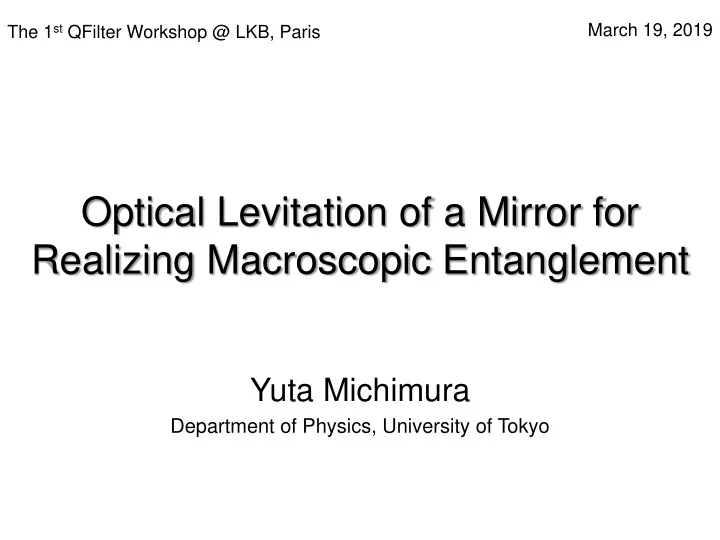

The 1 st QFilter Workshop @ LKB, Paris March 19, 2019 Optical Levitation of a Mirror for Realizing Macroscopic Entanglement Yuta Michimura Department of Physics, University of Tokyo
Self Introduction • Yuta Michimura Department of Physics, University of Tokyo • Interferometry in gravitational wave detectors - KAGRA - DECIGO • Test of fundamental physics using laser interferometers - Lorentz invariance - Macroscopic quantum mechanics - Axion search etc…… 2
Nobuyuki Matsumoto (Tohoku University) Yuta Michimura (University of Tokyo) Kazuyuki Takeda (Kyoto University) Koji Usami (RCAST) Kentaro Somiya (Tokyo Institute 3 of Technology)
Overview • Test of macroscopic quantum mechanics super position of position states of mg-scale mirrors • Optical levitation of a mirror no suspension thermal noise sandwich configuration reaching standard quantum limit is feasible YM+, Optics Express 25, 13799 (2017) • Technical challenge fabrication of mg-scale mirrors 4
Macroscopic Quantum Mechanics • Quantum mechanics is scale-invariant • But superposition of macroscopic objects are not observed • Many interpretations - too much classical decoherence - non-linear Schrödinger Eqs. - gravity decoherence …… • Test of quantum mechanics at various scales necessary to look into classical-quantum boundary 5
Previous Experiments • Benchmark for realizing quantum mechanics test: reaching the standard quantum limit (SQL) • Not yet achieved at mg-scale 6
Previous Experiments • Benchmark for realizing quantum mechanics test: reaching the standard quantum limit (SQL) • Not yet achieved at mg-scale 7
Previous Experiments • Benchmark for realizing quantum mechanics test: reaching the standard quantum limit (SQL) • Not yet achieved at mg-scale 8
Optical Levitation of a Mirror • Thermal decoherence due to mechanical support can be avoided with optical levitation Mechanical Suspension Optical Levitation radiation levitated pressure mirror thermal gravity noise tension gravity suspended mirror 9
Sandwich Configuration • Simple configuration than previous proposals • Upper cavity to stabilize the levitated mirror Levitated mirror S. Singh+: PRL 105, 213602 (2010) G. Guccione+: PRL 111, 183001 (2013) 10
Stability of the Levitation • Rotationally stable due to gravity • Vertically stable due to optical spring • Horizontally stable due to beam axis tilt Center Optical of axis tilt curvature spring gravity horizontal rotation vertical 11
Reaching the SQL is Feasible • 0.2 mg mirror, 13 W + 4 W input, finesse 100 Reaches SQL at 20kHz Quantum Laser frequency 12 Calculation by Y. Kuwahara
Technical Challanges • Fabrication of mg-scale mirrors mm-scale diameter, curved, HR/AR coated • Experimental demonstration of the stability • Procedure for tuning the alignment, power, detuning for the levitation experiment using torsion pendulum ongoing • Laser frequency noise 0.1 mHz/ √ Hz @ 20 kHz 13
Mirror We Need Upper side - flat - AR <0.5% 3 mm dia. 0.1 mm thick ~1.6 mg Lower side - RoC 30 mm - HR ~99% (finesse ~100) 14
Fabrication Prototype • Ordered (to company S) - mass 1.6 mg - φ 3mm, t 0.1 mm - RoC 30 +/- 10 mm - Reflectivity 99.95 % • Ordered 8, but received 7 (only 1 without cracks) - crack during coaing • Measured - RoC 15.9 +/- 0.5 mm - Reflectivity >99.5% 15 Plot by K. Nagano
Alternative Way? Upper side - RoC 30 mm - HR ~99% (create an etalon) 3 mm dia. 0.1 mm thick ~1.6 mg Lower side - RoC 30 mm - HR ~99% (finesse ~100) 16
Any Ideas Welcome! • We have been focusing on sensing vertical motion of a mirror, but sensitivity design is tough due to intracavity power constraints to levitate a mirror mirror rotation sensing? • Triangular pyramid mirror? • Levitate a mirror in space - less power since less gravity - 50cm cubic, ~50kg satellite could be feasible • Suspend curved mirror? - no alignment instability if curved 17
Supplementary 18
Parameters for Sensitivity Calc. 19 YM+, Optics Express 25, 13799 (2017)
Recommend
More recommend